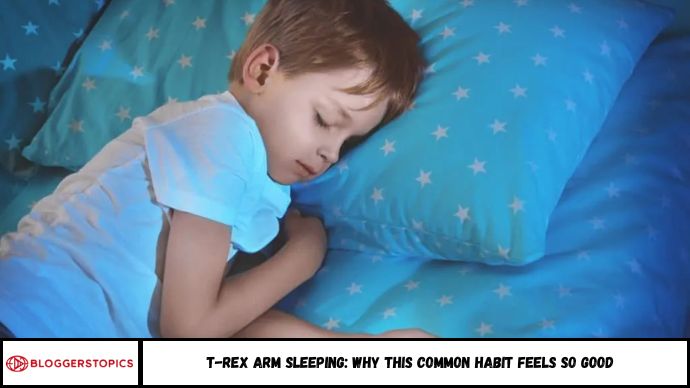T-Rex arm sleeping—where you tuck your arms close to your chest while lying down—is surprisingly common. This comforting sleep position is linked to feelings of safety, relaxation, and emotional self-soothing. In this article, we explore the psychology behind the habit, its benefits, and why so many people unconsciously choose it night after night.
Do you ever wake up with your arms curled tightly against your chest, like a tiny prehistoric predator? This quirky sleep position, popularly known as “T-Rex arm sleeping,” has caught attention online—and no, it doesn’t mean you’re transforming into a dinosaur in your sleep!
Instead, it simply describes how some people tuck their arms inward, resembling the famously short arms of a Tyrannosaurus rex. With its rising popularity on platforms like TikTok, many are curious: What does this “dinosaur pose” say about your sleep habits and overall well-being?
Why Do We Sleep with Our Arms Curled Like a T-Rex?
Ever wake up with your arms curled close to your chest, elbows bent, hands near your face—almost like a sleeping dinosaur? You’re not alone. This oddly specific pose, often called “T-Rex arm sleeping,” is more common than you might think.
What Is T-Rex Arm Sleeping?
T-Rex arm sleeping refers to a position where a person sleeps with their arms curled tightly toward their chest, resembling the tiny, bent forelimbs of a Tyrannosaurus rex. It often happens during side or stomach sleeping and is characterized by:
- Elbows bent
- Wrists or hands near the shoulders or face
- Tension held close to the body
It may look funny—but it’s incredibly common.
Why Do People Sleep This Way?
1. It Feels Safe and Secure
Curling your arms inward mimics the fetal position, a posture associated with safety and self-protection. This instinctive behavior dates back to infancy and signals a need for comfort or emotional regulation.
“It’s a natural way for the body to shield vital organs and feel safe,” says Dr. Wendy Troxel, a sleep specialist and behavioral scientist.
2. It Promotes Emotional Calm
According to sleep psychologists, this posture may also trigger parasympathetic nervous system responses, which help us relax. Just like hugging a pillow or swaddling a baby, it provides a calming, grounding sensation.
The Psychological Science Behind It
Linked to Childhood and Attachment
The T-Rex position may unconsciously mirror how we were held or comforted as children. This can activate emotional memory, promoting a sense of reassurance even in adulthood.
Stress Response and Self-Soothing
When you’re anxious, your body often seeks self-protective positions. Curling in—especially the arms—is a common way to self-soothe and reduce psychological stress during sleep.
Are There Physical Benefits Too?
Yes—depending on the individual. For some, this position:
- Reduces shoulder and chest strain
- Relieves pressure on the spine when side-sleeping
- Helps prevent hyperextension of the arms
However, for others, especially those with tight shoulders or nerve issues, it may cause tension or discomfort if held too long.
When Is T-Rex Arm Sleeping a Problem?
While it’s usually harmless, T-Rex arm sleeping might be a sign of underlying stress, anxiety, or poor sleep posture if you:
- Wake up with numbness or tingling in arms
- Have frequent shoulder pain
- Experience tightness in the neck or upper back
If discomfort persists, consider adjusting your pillow height or using a body pillow to relieve tension.
FAQs
1. What does T-Rex arm sleeping mean?
It’s a common sleep position where the arms are curled close to the chest—often linked to emotional comfort and safety.
2. Is it bad to sleep with your arms bent?
Not necessarily. It’s safe for most, but prolonged pressure may cause stiffness or nerve issues for some people.
3. Why do I sleep with my hands under my chin?
It’s a variation of T-Rex sleeping, offering emotional security and mirroring comforting behaviors from childhood.
4. Can this sleep style affect my posture?
If you wake up sore, it might be time to evaluate your pillow and mattress support.
5. Is this position related to anxiety?
Sometimes. Curling in during sleep can be a subconscious coping mechanism for stress or anxiety.
Conclusion
The T-Rex arm sleeping position may seem quirky, but it’s rooted in human biology, emotional psychology, and subconscious self-soothing. Whether you’re trying to unwind after a long day or unknowingly protecting yourself in your sleep, this common habit reflects your body’s natural instinct to feel safe, calm, and secure.







